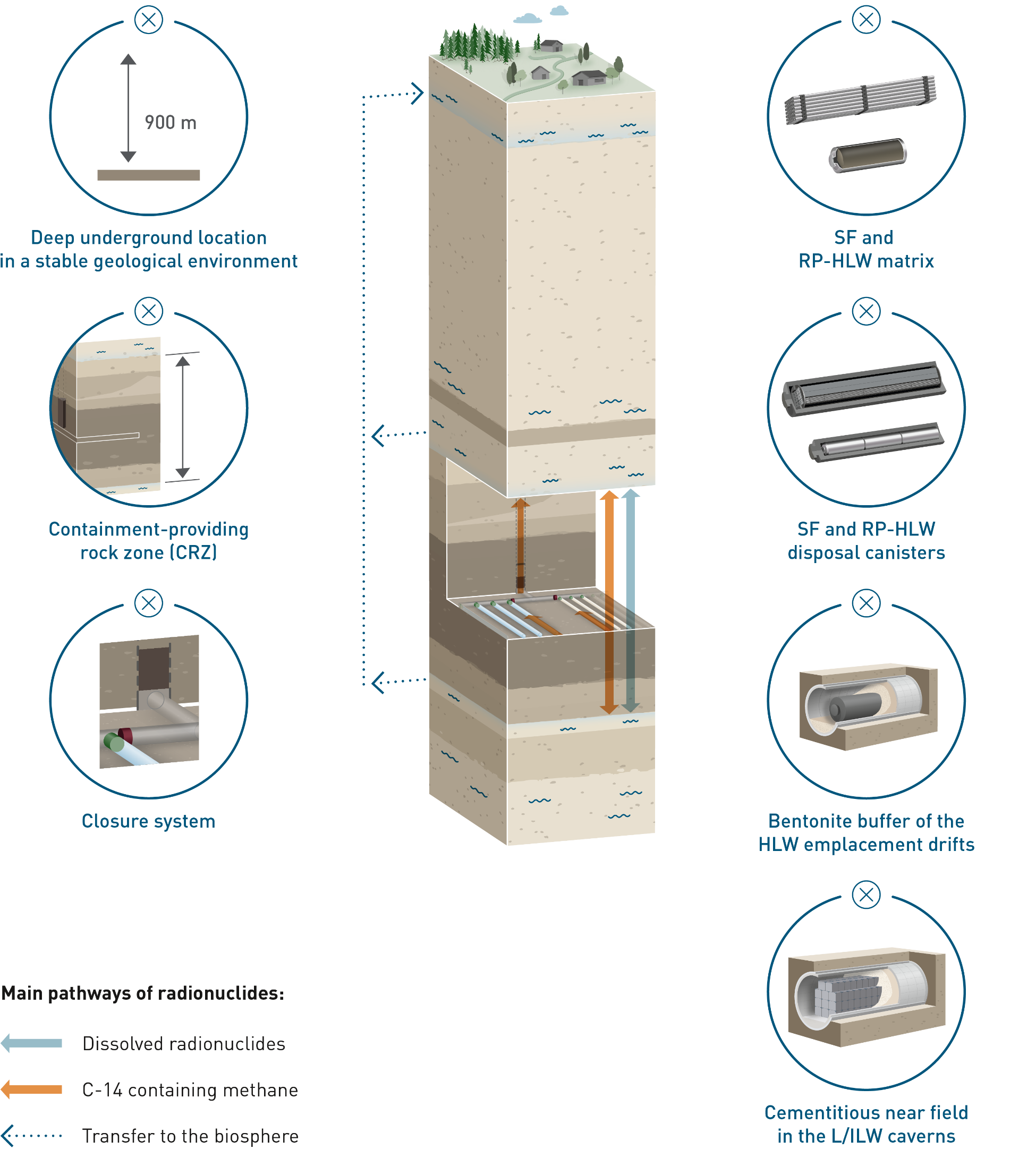Further “what-if?” cases are defined and analysed to test the robustness of the system, even in hypothetical situations in which, for no specific cause, certain key favourable features and processes fail to operate as expected or parameter values are assumed that are outside the range considered possible based on current scientific understanding. These cases are developed by systematically going through the pillars of safety17 and either removing them or assuming a degradation of the safety function they serve, as illustrated schematically in Fig. 7‑7.
Each pillar of safety addressed can be considered a variant and, depending on the characteristic of each pillar, several calculation cases are defined and propagated to radiological consequence analysis.
For the CRZ these are:
-
two calculation cases, one with no sorption of radionuclides in the CRZ (WI-CRZ-NOSORB) and another with hypothetically high diffusion coefficients in the CRZ (WI-CRZ-DIFF),
-
two calculation cases with hypothetically high downwardly or upwardly directed hydraulic gradients (WI-CRZ-GRADdown and WI-CRZ-GRADup),
-
one calculation case assuming no upper and lower confining geological units around the host rock (WI-CRZ-NOCONFINING),
-
and a calculation case with hypothetically high radial dimension of the EDZ around the emplacement rooms (WI-CRZ-EDZ).
For the HLW matrices, the calculation cases assume a hypothetically high instant release fraction for radionuclides in spent fuel (WI-SF-IRF), hypothetically high matrix dissolution rates for spent fuel and the glass matrix for reprocessed waste (WI-HLW-DISS) and hypothetically high corrosion rates of spent fuel cladding and other structural parts (WI-SF-CORR).
For the HLW disposal canisters, a calculation case (WI-HLW-CAN) assumes the hypothetical early failure of all canisters after 1,000 years.
For the bentonite buffer in the HLW emplacement tunnels, no solubility limits (WI-HLW-NOSOL) or no sorption (WI-HLW-NOSORB) in the near field and hypothetically high diffusion coefficients (WI-HLW-DIFF) or a hypothetically high permeability of the bentonite buffer (WI-HLW-BUF) lead to four calculation cases.
For the L/ILW cementitious near field, no sorption (WI-L/ILW-NOSORB) and an instant release of all 14C present (WI-L/ILW-C14) are considered.
Finally, the failure of the closure system leads to five calculation cases with hypothetically high permeabilities for the different types and locations of seals: WI-V1-HLW, WI-V1-L/ILW, WI-V2-HLW, WI-V2-L/ILW, WI-V3.
The calculation cases are also summarised in Tab. 8‑8 in Section 8.4.2, where the results are presented and discussed.

Fig. 7‑7:Schematic illustration of the approach to develop “what-if?” cases postulating a hypothetically degraded performance of the pillars of safety (indicated by “×”)
The only pillar of safety not considered here is a deep underground location in a stable geological environment. The “what-if?” cases related to physical phenomena described in Section 7.5.1 can, however, be seen as examples of the degradation of this pillar of safety. Specifically, if fault re-activation is caused by a large earthquake, this implies a less stable than expected geological environment. Excavation of the repository by erosion processes implies that the deep underground location no longer exists. ↩

